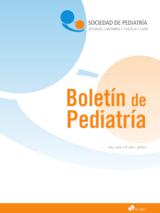Clasificación, diagnóstico y tratamiento de los trastornos miccionales en la infancia
M.E. Molina Vázquez , C. Botía Martínez , R. Tejerina López , O. Gómez Beltrán , R. Aguilar Cuesta , J. Pradillos Serna
Bol. Pediatr. 2023; 63 (265): 153 - 161
La disfunción vesical o disfunción del tracto urinario inferior(DTUI), traducción literal del inglés de Lower urinary Tract Disfunction (LUTD) puede ser causa del 40% de las consultas en pediatría. Estos trastornos suponen una alteración en cualquiera de las fases del ciclo miccional y pueden responder a causas neurológicas, anatómicas o funcionales. Es muy importante realizar una adecuada historia clínica que nos permita conocer al paciente de manera global de manera que podamos lograr un correcto diagnóstico de la causa de la disfunción y así poder realizar un tratamiento dirigido. La evaluación de la mayoría de los niños con disfunción vesical puede limitarse a una anamnesis exhaustiva, un examen físico y pruebas no invasivas, como un análisis de orina y un urocultivo. En niños seleccionados, una evaluación más extensa incluye estudios de imagen urológicos, mediciones del flujo urinario y determinación del residuo postmiccional. En cuanto a las herramientas terapéuticas, partiremos de pautas higiénico-dietéticas básicas y de aplicación global a las que podremos asociar terapia conductual, farmacológica, fisioterápica o quirúrgica, siempre de manera individualizada.
Classification, diagnosis and treatment of urinary disorders in childhood
Vesical disfunction or Lower urinary Tract Dysfunction (LUTD), can be the cause of 40% of pediatric consultations. Dysfunctions of the lower urinary tract involve an alteration in any of the phases of the voiding cycle and may respond to neurological, anatomical or functional causes. It is very important to take an adequate clinical history that allows us to know the patient globally so that we can achieve a correct diagnosis of the cause of the lower urinary tract dysfunction and thus be able to carry out targeted treatments. The evaluation for most children with bladder dysfunction can be limited to a thorough history, physical examination, and noninvasive testing, such as a urinalysis and urine culture. In selected children, more extensive evaluation includes urologic imaging studies, measurements of urinary flow, and post-void residual determination. As for therapeutic tools, we will start from basic hygienic-dietary guidelines of global application to which we can associate behavioral, pharmacological, physiotherapy or surgical therapy, always in an individualized manner.
Artículo completo (PDF) (620 kb.)
- Nefrourología
Buscar en el boletín
Año 2023, Volumen 63, Número 265

Boletín completo en PDF (8741 kb.)